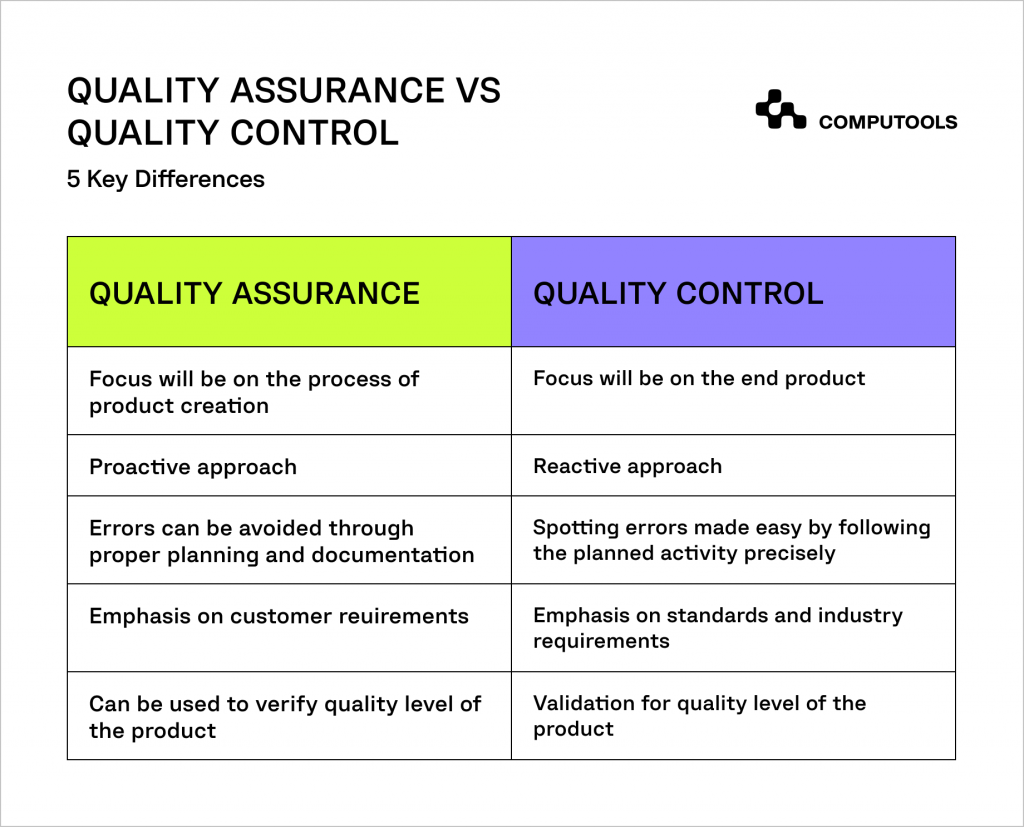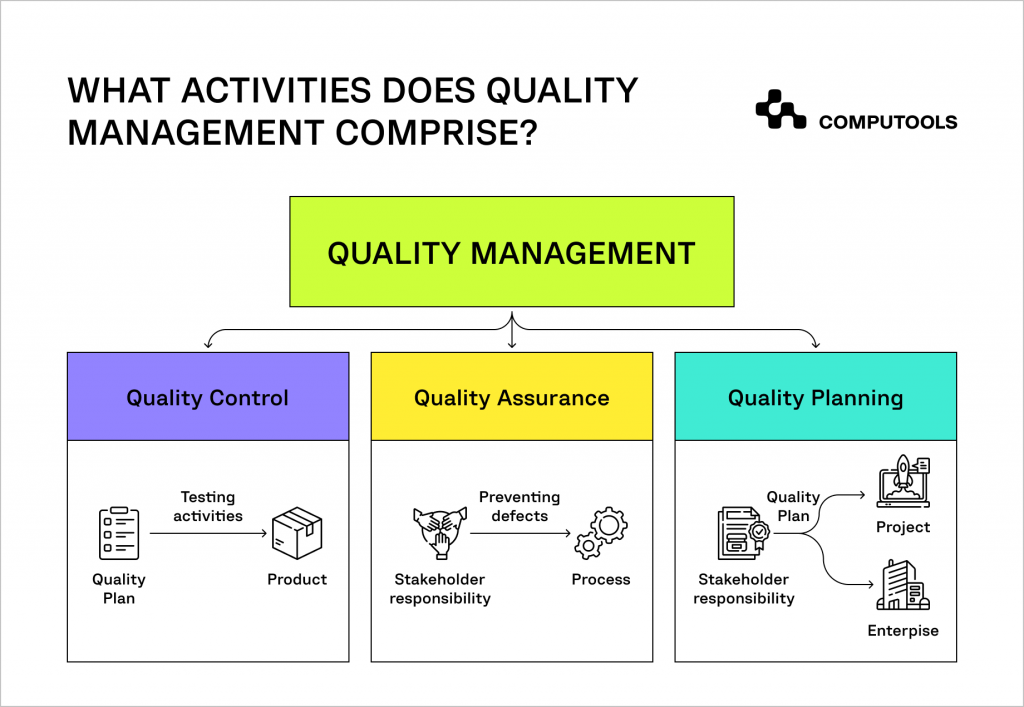Did you know the average app loses 95% of users after 90 days? What about 68% of consumers referring to bad experiences as reasons for churn? How come less than 25% of app users return after day one? Do you still want to quit quality assurance? Let’s explore why quality assurance and software testing services are important!
What is Quality Assurance?
It’s a common misconception that QA engineers focus on identifying bugs and glitches in the software. However, one can be surprised by this role’s vast responsibilities. Being closely tied to development processes, QA specialists lead the project before the back-end and front-end developers begin their work.
The initial goal of quality assurance is to help the development team deliver their work on schedule while ensuring that the end product complies with the predetermined quality standards. The QA processes run parallel to the development processes throughout the entire software development cycle to prevent any significant issues and ensure that the requirements are met optimally.
Sometimes, people misunderstand quality control and quality assurance since quality control falls under the umbrella of quality assurance. QA testing encompasses all technical aspects across every stage of development and focuses more on quality processes than direct testing. On the other hand, quality control concentrates on conducting direct testing utilizing established processes, techniques, and tools to identify bugs and defects.

QA Comprises Five Phases:
1. Requirements Gathering: The QA testing team gathers user requirements and documents them precisely. This guarantees that all stakeholders are informed about the product’s intended functionality, as well as any potential concerns.
2. Test Planning: The Quality Assurance team devises and implements tests to verify that the software meets the set requirements. In dependence on the software being tested, these tests can be manual or automated.
3. Testing: In order to adhere to all requirements, the Quality Assurance team performs user testing, which also includes interviews, walkthroughs, and scenario studies.
4. Defining/Documenting Bugs: The QA team identifies and records any defects detected. Defects can manifest in many forms, ranging from minor errors to more intricate issues that may potentially jeopardize the safety or functionality of the users.
5. Fixing Defects: Throughout the testing life cycle, the Quality Assurance team proactively assists developers in eliminating defects, as well as creates a case study, describes the problem, and communicates with the developers. Then, the QA team transfers the report to developers for further improvement and optimization.

Quality Assurance Attributes
Any software product can reach exceptional levels of performance and customer satisfaction, ensuring its success in a highly competitive market. There are 4 basic quality assurance attributes:
• Functionality: The software should be easy to navigate and understand.
• Usability: The user interface should be visually appealing and intuitive.
• Reliability: The software should be authentic and error-free.
• Security: The software should protect user data from unauthorized access or modification.
Why Does Software Have Bugs?
Software bugs can occur for many reasons, with human errors in software design and coding being the most prevalent cause.
1. Miscommunication
The efficiency of any software application depends on effective communication among stakeholders, development, and testing teams. Unclear requirements and misinterpretation are the two primary reasons for software defects.
2. Complex Software Architecture
Enormous relational databases and large-scale applications consistently contribute to the exponential growth in software/system complexity.
3. Programming Errors
IT professionals are also receptive to making common programming errors. Not all developers possess domain expertise, and inexperienced programmers or those lacking sufficient domain knowledge may introduce basic coding errors. The absence of coding practices, unit testing, and debugging are among the usual reasons for such issues to arise during the development stage.
4. Changing Requirements
Changes requested by the customer can significantly impact the project, including redesign, team rescheduling, etc. It can also result in the need to redo or toss out completed work, affect hardware requirements, and more. Keeping track of changes and their dependencies can be complex and may lead to errors, affecting the enthusiasm of engineering staff.
5. Rigid Timeline
Scheduling software projects is a challenging task, often requiring guesswork. Mistakes are likely to occur when deadlines are approaching, and the pressure is high. Tight schedules can be a major concern in small-scale projects or companies, resulting in software bugs.
6. Obsolete Automation Scripts
Automation scripting can be time-consuming, especially for complex scenarios, and outdated test scripts can lead to inadequate tests. Proper validation of results in automation testing is crucial to catch defects effectively.
7. Lack of Skilled Testers
The success of a project dramatically relies on having skilled testers who possess domain knowledge. However, not all companies can afford to hire experienced professionals. It’s critically essential for testers to have domain knowledge.
Remember that software testing services can significantly minimize risk, boost quality assurance and improve IT performance.
You now see that QA engineers help the business to:
• Identify weaknesses and inconsistencies in the product at all project stages
• Help define project requirements
• Provide comprehensive information about the level of quality of a product
• Test the product during all phases of the software development lifecycle (SDLC)
• Ensure that the product is user-friendly in terms of functionality and design
• Communicate with all team members and refer to the given requirements
Delight your users with helpful features and reliable applications!
Contact us →Automated Testing vs. Manual Testing
Automated and manual testing has its pros and cons. Automated testing offers the undeniable benefit of speed, with much faster testing times than manual methods. In addition, there are many tools available that can create multiple tests and run them simultaneously, saving time. Automated testing is crucial for large projects requiring performance and load testing.
Manual testing plays a critical role in adding a significant “human element” to software, which helps to ensure the best possible user experience and meet their specific needs effectively. By performing manual software testing and quality management, we can determine whether the visual components, such as layout and text size, are optimized for the best UX/UI performance.
Combining automated and manual testing is essential for every project as manual testing is prone to human errors, while automated testing is highly accurate. However, manual testing can be time-consuming and requires significant human resources, making it impractical for test cases that require frequent repetitions.
When combined, manual and automated testing complements each other and comprehensively covers software flaws. The benefits of quality assurance for the product are clear, as a lack of testing can result in more significant bugs.

Advantages of Quality Assurance for Business
1. Time-Efficiency
Although it requires an initial investment of time to establish error-catching systems, the time needed to fix errors is significantly greater if they are permitted to occur or escalate. One study demonstrated that addressing an issue during the production phase can take up to 150 times longer than addressing it during the requirements design phase.
2. Cost-Efficiency
Some businesses might be doubting quality assurance because of its cost. However, it saves money in the long run. Every company should remember that preventing problems is cheaper than fixing them.
3. Customer Confidence
As a rule, companies that take pride in their consistency always do better with their end users. People are ready to spend money on products and services, but only if they get something worth the price. When a company promotes quality assurance, it takes care of its customers.
4. Brand Reputation
In the highly competitive business world, a good reputation is key. A company’s reputation translates into loyalty, so customers will want to stick with a successful business they trust. Eventually, quality assurance is an essential aspect of an excellent reputation.
5. Employee Morale
When employees clearly understand what they should do and what’s expected, they are less stressed and can focus on meeting established standards. In addition, company-wide quality assurance practice also extends to their faith in their employer.
Conclusion
Quality assurance importance is hard to ignore since it is the most critical aspect of the software development process. It helps ensure that the end product meets the required quality standards. In any case, quality assurance doesn’t just apply to the final product. Instead, it should be integrated throughout the entire development process, from early design to final testing.
Contact Computools’s experts now at info@computools.com to learn how quality assurance can help your business develop quality products.









Computools was selected through an RFP process. They were shortlisted and selected from between 5 other suppliers. Computools has worked thoroughly and timely to solve all security issues and launch as agreed. Their expertise is impressive.